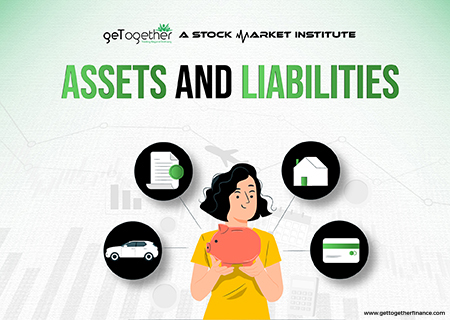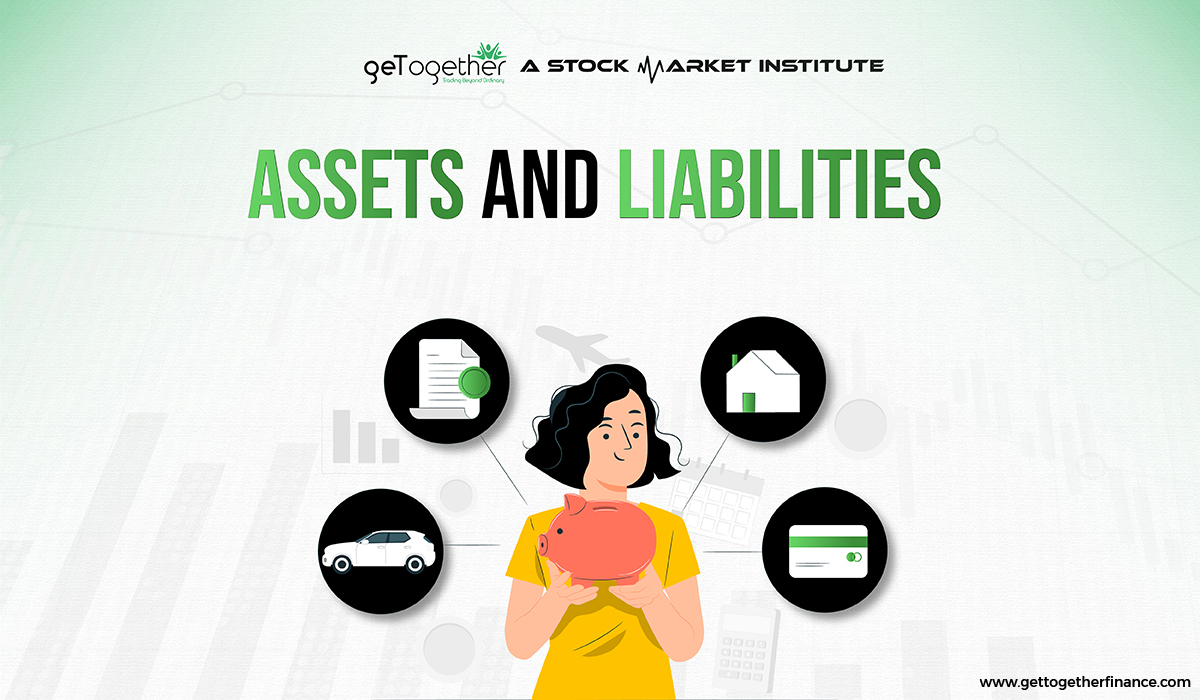ASSETS AND LIABILITIES


In the world of the stock market, the concepts of assets and liabilities serve as vital pillars to display a company’s financial situation. Assets contribute to the company’s credibility. They can be money, infrastructure, inventory, machinery, etc. Whereas liabilities are the obligations for payments due to the depreciation of the products. Examples of liabilities can be short-term loans, mortgage payments, debts, etc. Though, liabilities showcase the debts that needed to clear off, a good balance between assets and liabilities is important.
Table of Contents
ToggleWhat are assets?
Assets are the economic resources that are owned by the company that contributes to its net worth. Assets are economically beneficial as they help in the financial growth of the company. There are two core types of assets: tangible and intangible. Tangible assets include physical items such as real estate, inventory, and so on, while intangible assets comprise intellectual property, patents, copyrights, and trademarks.
Additionally, financial assets like stocks, commodities, and bonds can also be bought by the company. Furthermore, assets can be broadly categorised into two main types:
1. Current Assets:
As its name refers, current assets are the type of assets that can be liquidated in a short time frame. It means these assets can be converted into cash in less than a year. Examples of current assets include cash, inventory, cash equivalents, i.e. treasury bills, and short-term investments in the stock market.
2. Fixed Assets:
Fixed assets are long-term assets that cannot be converted into cash immediately or in a short time period. These assets are usually bought for long-term use to serve a purpose. For example, real estate, machinery, vehicles, land, furniture, etc.
What are Liabilities?
Liabilities are debts or borrowing that a company has to bear. Simply, liabilities are everything that a company owes in the market. They arise from borrowing funds or obtaining goods and services on credit. Liabilities can be classified into two types:
1. Current Liabilities:
Current liabilities are generally short-term obligations that have to be settled within a year. Examples include accounts payable, short-term loans, credit card debts, and so on.
2. Fixed Liabilities:
Fixed liabilities are also known as long-term liabilities. These obligations have a due date longer than one year and can be settled accordingly. For example, long-term loans, mortgages, and deferred tax liabilities.
Also Read: Market Capitalization
Examples of Assets and Liabilities

Assets
Assets are resources owned by a company or a business that have an economic value and pride benefits to the company. Some of its examples are:
- Cash and Cash Equivalents: These can be physical currencies(cash), the bank balance of the company, and other liquid assets that provide monetary benefits to the company.
- Accounts Receivable: It is the money that is owed to the company or the business by customers or clients for goods and services provided to them.
- Inventory: The goods available for sale, raw materials or work-in-progress goods, work-in-progress, and finished products available to keep the business running.
- Property, Plant, and Equipment (PP&E): These are tangible assets like buildings, machinery, transportation, or any other real estate.
- Investments: These are the stocks, bonds, securities or any other security owned by the company or the business.
- Intangible Assets: Non-physical assets like patents, trademarks, and goodwill.
Liabilities
Liabilities are the obligations of the business that it needs to settle in the future. It represents claims against assets owned by the business. Some of its examples are:
Liabilities are obligations that a business needs to settle in the future, representing claims against its assets. Examples include:
- Accounts Payable: It is the money that a business owes to suppliers and vendors for the goods and services bought on credit.
- Loans Payable: This is the amount owed to lenders, including short-term and long-term loans in the company’s name.
- Bonds Payable: These are the long-term debt securities issued by the company to investors.
- Salaries and Wages Payable: It is the Amount or salaries owed to employees for their services.
- Taxes Payable: Payables to government entities for taxes on the revenue and profit generated.
- Deferred Revenue: Money received by a company in advance for goods or services to be delivered in the future.
How to Calculate Assets

Simply, the sum of all individual assets owned by the company is total assets. The formula is:
In the above formula:
- Current Assets are the assets that are expected to be converted into cash within a year. Such as cash, accounts receivables, and inventory that can be sold.
- Non-current assets are long-term assets owned by the company like property, plant, and equipment, and intangible assets.
How to Calculate Liabilities
The sum of all the obligations that a business has helps in calculating liabilities. The formula is:
In the above formula:
- Current Liabilities are obligations on the company that are due within a year, like accounts payable and short-term loans.
- Non-Current Liabilities are long-term obligations on the company like long-term loans and bonds payable to investors till the maturity date.
Equity

Equity represents the shareholder’s or owner’s interest in the business and is calculated as the difference between total assets and total liabilities. Its formula is:
Equity can also be broken down into components such as:
- Common Stock: Total value of shares issued to shareholders
- Retained Earnings: profits that have been reinvested in the business rather than distributed to shareholders in the name of dividends.
- Additional Paid-In Capital: Any excess amount paid by investors over the par value of the stock.
Why do assets and liabilities play an important role in the stock market?
Assets and liabilities help investors in making decisions based on the financial data of the company. This financial data includes its balance sheets, profits, losses, loans, etc. Therefore, data on assets and liabilities can help in predicting the way the company is heading towards. If the company has good financials and is using its assets and other resources wisely, its stock is bound to go up. Whereas, when the company is not clearing its debts on time and struggling financially, its stock price may decline.
Here’s how having adequate knowledge of assets and liabilities can help investors:
- Investors can have a clear look at the company’s assets like real estate, inventory, equipment, etc. Having good and valuable assets indicates a good market capital for the company, thus investors consider it as a reliable stock.
- If the company has excessive and long-term liabilities, investors take it as a negative sign. This makes the company vulnerable to economic downturns and natural calamities.
- Dividends are shared with the investors when the company earns good profits. A good asset-to-liability ratio helps investors in gauging the company’s future profits. Investors focus to invest in stocks that are forecasted to give good dividends along with returns.
- If the company has long-term liabilities, then its growth can be hindered. In this case, the company does not have the funds to expand its business. Instead, they need profits to clear off debts. This can lead to a decline in the stock price.
- If the company has unique assets, it has a competitive advantage over others. Also, it increases the credibility of the company which increases investor interest.
Conclusion
Assets and liabilities are the foundation or we say a base of financial decision-making while analyzing a company. Educating yourself with these concepts empowers you to make informed financial decisions. It gives an overview of both stocks and bonds that fuel growth to the accounts payable that necessitates responsibility. By striking an adequate balance between assets and its liabilities companies can embark on a journey towards financial prosperity and stability. So let’s navigate the financial landscape with these financial elements and explore a path that will take us to better financial well-being.
FAQs
1. How are assets and liabilities related to net worth?
Net worth is the difference between total assets and total liabilities. The positive net worth of the company indicates that a company’s assets exceed its liabilities, while the negative net worth of the company indicates that liabilities overweight assets.
2. Why are assets and liabilities important for business?
In assessing the company’s financial health, risk exposure and performance assets and liabilities play crucial roles. They are also responsible for the valuation of companionship and the growth of that company.
3. How do individuals use assets and liabilities for financial planning?
Individuals can use both these to access their financial health, manage debt and plan for the future. By optimising assets and reducing liabilities one can reach financial stability.
4. Are assets and liabilities only related to finances?
They are mainly associated with finances, but the concept can extend beyond financial matters. In personal and business contexts, assets can include valuable skills, intellectual property, and resources. Liabilities can involve responsibilities, obligations, and debts beyond just financial ones.
5. Can assets become liabilities?
Under certain circumstances, assets can turn into liabilities. For example, owning a second property initially considered an asset can become a liability if it incurs significant maintenance costs and property taxes without generating income.
CATEGORIES



 Facebook
Facebook Instagram
Instagram Youtube
Youtube
